Adrian Collins's Blog, page 109
January 21, 2023
REVIEW: Fatale Vol. 1: Death Chases Me by Ed Brubaker and Sean Phillips
Fatale Vol. 1: Death Chases Me by Ed Brubaker and Sean Phillips is a work that I picked up after the fantastic The Fade Out comic. I’m a huge fan of film noir and it was some of the best art as well as writing I’ve found in comic books period. I wasn’t a fan of the ending but I still wanted more and my friends said that not only was Fatale similar in some ways but it had my other proverbial catnip: Lovecraftian horror.
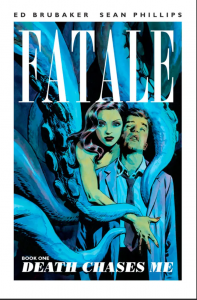 Fatale is a deconstruction of the classic film noir trope: the femme fatale. Cherchez la femme or “look for the woman” is such a cliche in the dark and seedy storytelling that it was ripe for parody/subversion in the Seventies. Chinatown, without spoiling the plot, depends greatly on the idea that Jake Gittes can’t get it out of his head that Mrs. Mulray must be running some sort of scam on him because film noir dictates that a beautiful rich woman must somehow be evil or manipulative. The Maltese Falcon depends on Brigid O’Shaughnessy being a lying sociopath and The Big Sleep, Lauren Bacall’s charms aside, is a story around two devious women with one being a psychopath.
Fatale is a deconstruction of the classic film noir trope: the femme fatale. Cherchez la femme or “look for the woman” is such a cliche in the dark and seedy storytelling that it was ripe for parody/subversion in the Seventies. Chinatown, without spoiling the plot, depends greatly on the idea that Jake Gittes can’t get it out of his head that Mrs. Mulray must be running some sort of scam on him because film noir dictates that a beautiful rich woman must somehow be evil or manipulative. The Maltese Falcon depends on Brigid O’Shaughnessy being a lying sociopath and The Big Sleep, Lauren Bacall’s charms aside, is a story around two devious women with one being a psychopath.
It’s a trope as old as Circe, Medea, and Morgan Le Fey. Actually, one may argue that it goes back to the very first novel ever written with Ishtar unleashing holy hell on Gilgamesh because he wouldn’t sleep with her. It is a double-edged sword as while it may be considered a misogynist trope, it is also something that grants agency to female characters. As one of my female friends explained: “Maleficent is the best of Disney’s female characters and I don’t mean the Angelina Jolie one.”
In this case, Fatale is essentially the story of the most beautiful woman in the world. Josephine AKA “Jo” has the supernatural power to turn any man into her slave by simply looking at him. They fall in love at first sight and gradually fall under her sway to the point that all of their previous relationships become meaningless. Happily married to a pregnant wife? Doesn’t matter. A deranged religious fanatic? Doesn’t matter. It’s not something she can turn off either and has led to countless ruined lives.
While Josephine, herself, plays an important role, it’s actually three separate men who fall in love with her that form the majority of the story. A man investigating his writer grandfather’s death, a happily married reporter, and an aging cancer-ridden police officer who has been Jo’s lover for decades. All three of them have a self-destructive streak a mile wide and they blame Jo, justly or unjustly, for leading them to the ruination they all face. They want her beyond anything else but also hate that she has that kind of power over them. If it is a form of love, it is a selfish and ugly sort.
Opposing our antiheroes is what appears to be the Cult of Cthulhu, though that title is never given to them despite the abundance of robes, human sacrifice, tentacles, and squid-faced monsters that are involved in their magic. Either way, they are led by the mysterious Bishop that wants Josephine to be a sacrifice and is willing to offer anything to those who can bring her to him. It’s funny, in a black comedy sort of way, that the only man Josephine could have a relatable conversation with is a demonic monster in human skin.
Readers should be warned this is a DARK f***ing book. People are horribly maimed, innocent people are murdered in blood sacrifices, and there’s very few in the way of happy endings. Unlike The Fade Out, there’s very little in the way of nudity with the lovingly illustrated images of Josephine being mostly suggestive rather than explicit. Jo is a spectacular comic book beauty and you can believe she has that je ne sais quoi (wow, there’s a lot of French in this review) even without magical powers.
Read Fatale Vol. 1: Death Chases me by Ed Brubaker and Sean PhillipsThe post REVIEW: Fatale Vol. 1: Death Chases Me by Ed Brubaker and Sean Phillips appeared first on Grimdark Magazine.
Grimdark Magazine Issue #33 is here!
Is it that time of the quarter again? Sure is! Grimdark Magazine Issue #33 is here. Beth Tabler has pulled together another amazing list of contributors and based on our Patreon Subscribers’ early reviews over on Goodreads, she’s absolutely nailed it once again. Let’s get stuck into what GdM fans will be getting their teeth into this quarter.
Cover for GdM#33 by Carlos DiazOnce again our wonderful cover artist Carloz Diaz has absolutely nailed it. This quarter, the cover is based upon Gareth Ryder-Hanrahan’s story Bargaining. Make sure you give Carlos’ Insta a follow to see more of what he’s putting out there.
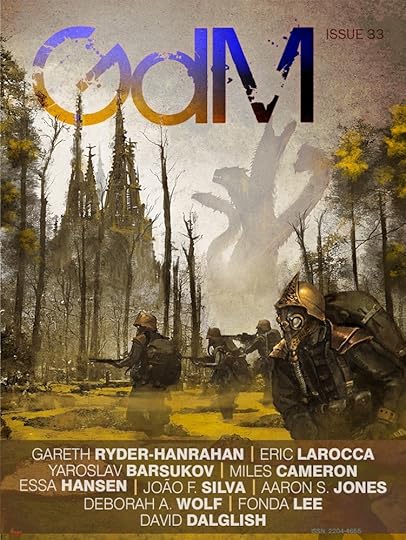
Once again, our new (-ish, now, I suppose!) editor Beth Tabler has made sure to pack out your issue of Grimdark Magazine with a diverse range of SFF voices from around the world. This issue includes:
FICTIONBargaining by Gareth Ryder-HanrahanThe Last Radio God by Yaroslav BarsukovCrimson Shows the Way of Joy by Eric LaRoccaLan Thena – Tales from the Bronze Age by Christian CameronSave, Salve, Shelter by Essa HansenThe Calvary by João F. SilvaNON-FICTIONReview: The House of Good Bones by T. KingfisherInterview with David DalglishThe Toxic Side of Fandom by Aaron S. JonesReview: The Crane Husband by Kelly BarnhillReview: The God of Endings by Jacqueline HollandThere’s a Monster in the House (and it is us) by Deborah WolfReview: Untethered Sky by Fonda LeeAn Interview with Fonda LeeRead Grimdark Magazine Issue #33As of this posting, we are currently in the process of once again being stuck in the approval stage by Amazon on the release of our issue. I’m not sure if we’ve been red-flagged or anything, but here we are a week in after submitting and still nothing from them.
Anyhow.
Until I have the Amazon page finally approved and live and can share that, I’m giving you the link to our webstore which has an ePub file available for download. You can send that file directly to your Kindle library and get reading whenever you’re ready, using these instructions.
The post Grimdark Magazine Issue #33 is here! appeared first on Grimdark Magazine.
January 20, 2023
REVIEW: The Blood of Outcasts by D.A. Smith
The Blood of Outcasts is the feudal Japanese-inspired grimdark fantasy from D.A. Smith, the first entry in his Bane Sword Saga.
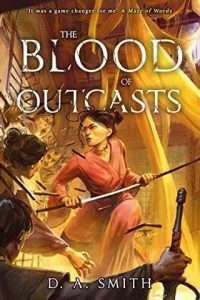 The protagonist of The Blood of Outcasts, Dattori Masako, is grimdark to the core. Although presumed dead by execution, a blood curse has brought her back to wreak vengeance on behalf of her slaughtered clan.
The protagonist of The Blood of Outcasts, Dattori Masako, is grimdark to the core. Although presumed dead by execution, a blood curse has brought her back to wreak vengeance on behalf of her slaughtered clan.
The premise for The Blood of Outcasts evokes a cross between two of my favorite grimdark novels: Prince of Thorns by Mark Lawrence and The Sword of Kaigen by M.L. Wang. Like Prince of Thorns, The Blood of Outcasts is told from the point of view of a brutal, take-no-prisoners narrator who is hellbent on revenge. As in The Sword of Kaigen, the fantasy world directly adopts many aspects of Japanese culture.
Notwithstanding the occasional flashback chapter, The Blood of Outcasts is told in the first- person present tense, giving the story a sense of urgency. The flashbacks switch to past tense, except for the final flashback chapter which, confusingly, is written in the present tense.
As in Prince of Thorns, D.A. Smith’s writing incorporates heavy use of short sentences. This may be off-putting for some readers, but I think it is an effective way to convey Masako’s harried mental state, especially during the numerous fight scenes. In this way, D.A. Smith
provides one of the most authentic point-of-view experiences that I have read in fantasy.
The combat scenes in The Blood of Outcasts are exceptionally well written, making the reader feel like they are immersed in the middle of the action. The influence of manga is apparent throughout these action scenes. D.A. Smith even describes The Blood of Outcasts as his love letter to the manga series Rurouni Kenshin.
The Blood of Outcasts largely succeeds as a character study of the monomaniacal Masako, who is relentless in her pursuit of revenge as she seeks to restore honor to her clan. But the novel also suffers from Masako’s tunnel vision, which restricts our ability to get to know other characters and to learn about broader aspects of the world.
A major part of what makes Prince of Thorns work is that Jorg’s brutality is balanced by his wickedly dark sense of humor. In contrast, Masako is dead serious throughout The Blood of Outcasts which, as a result, suffers from a sameness of tone that grows a bit tiresome over the novel’s nearly 500 pages.
Overall, D.A. Smith has created a compelling grimdark heroine with Masako, but I was left hungry to learn more about the world outside of her point of view. Still, fans of Japanese- inspired fantasy may find much to enjoy in The Blood of Outcasts.
3/5
Read The Blood of Outcasts by D.A. SmithThe post REVIEW: The Blood of Outcasts by D.A. Smith appeared first on Grimdark Magazine.
January 19, 2023
REVIEW: Wistful Ascending by JCM Berne
Wistful Ascending is JCM Berne’s heart-pounding superhero space opera and the first installment in his Hybrid Helix trilogy.
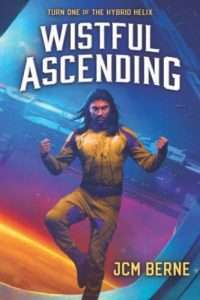 Rohan is a hybrid, with a human mother and an alien father from the imperialist il’Drach race. He has inherited superpowers from the paternal side of his family, including super strength, toughness, and the ability to fly. After spending a decade fighting an intergalactic war, Rohan now wishes to live a quiet, anonymous life as a Tow Chief Second Class on the space station Wistful, using his superpowers only to help visiting spacecraft dock on the station.
Rohan is a hybrid, with a human mother and an alien father from the imperialist il’Drach race. He has inherited superpowers from the paternal side of his family, including super strength, toughness, and the ability to fly. After spending a decade fighting an intergalactic war, Rohan now wishes to live a quiet, anonymous life as a Tow Chief Second Class on the space station Wistful, using his superpowers only to help visiting spacecraft dock on the station.
The universe of Wistful Ascending is full of diverse alien races that would make Gene Roddenberry proud. True to Captain Kirk form, there is also romance between Rohan and a beautiful alien woman, Tamara. Fortunately, JCM Berne presents the romance in a tasteful and realistic fashion, as two adults with established, independent lives full of real-world doubts about themselves and their relationship.
The most prominently featured of the alien races is a species of space bears. Not having a name for this species in human tongue, Rohan calls them Ursans and gives their leader the name Ursula. Reading about the Ursans was a lot of fun, particularly as Rohan ponders what relationship they have, if any, to the bears of his native Earth.
Wistful Ascending is full of space action. Despite Rohan’s superpowers, JCM Berne conveys a real sense of vulnerability for our hero. I found myself holding my breath while reading several of the action scenes.
One of the most innovative aspects of Wistful Ascending is JCM Berne’s worldbuilding, which includes sentient space stations and spaceships. I thoroughly enjoyed the dialogue between Rohan and the space station, Wistful, as well as the sense of mystery about Wistful’s history.
JCM Berne’s writing is crisp and witty, and his character work is excellent. However, the pacing suffers a bit, especially in the first half of Wistful Ascending. Also, the abrupt tonal shifts between chapters can be jarring, with chapters of high-intensity action immediately followed by low-key conversations over coffee.
Through his compelling storyline and realistic character development, JCM Berne convinced this cynical grimdark reviewer that superheroes can actually be cool. Although the first half of the book has a rather lighthearted tone, the plot darkens considerably in the second half as Rohan comes to terms with his inner demons and sense of, yes, wistfulness.
Overall, Wistful Ascending is a fun, action-packed story with relatable characters, witty dialogue, innovative worldbuilding, and enough thematic depth to balance the more lighthearted aspects of the story.
4/5
Read Wistful Ascending by JCM BerneThe post REVIEW: Wistful Ascending by JCM Berne appeared first on Grimdark Magazine.
January 18, 2023
REVIEW: Kindred by Octavia E. Butler
In Octavia E. Butler’s Kindred, Dana discovers she can transport from the 1970’s to the 1800s, where her skin makes her a slave. One moment she’s unpacking in her new house with her husband Kevin, and the next moment she’s saving a child named Rufus from drowning. Fifteen seconds later in her own time, she’s back standing in front of her husband, having lived in 1815 for many minutes more than she’d been away.
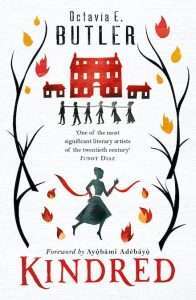 This begins a series of time jumps where whenever Rufus is in danger, Dana is involuntary jumped back in time to save him. Only, he is the son of a plantation owner, and she is black. As she gets to know this boy, and then man, she hopes there is a chance her more modern values and her influence as his ongoing saviour might allow her to make the lives of the slaves on the plantation slightly better. Perhaps she can get some of them free.
This begins a series of time jumps where whenever Rufus is in danger, Dana is involuntary jumped back in time to save him. Only, he is the son of a plantation owner, and she is black. As she gets to know this boy, and then man, she hopes there is a chance her more modern values and her influence as his ongoing saviour might allow her to make the lives of the slaves on the plantation slightly better. Perhaps she can get some of them free.
Published in 1979, Kindred is a brilliant read, engaging and written in an easy style I could have read and appreciated back in my teens. What I would not have been prepared for in my teens—and what I probably still can’t fully appreciate as a relatively privileged adult living on the other side of the planet—is the deep, dark look at the horror of a slave’s plantation life. Watching Dana experience both her own ancestors in a life she’d only read about before, plus the slow movement of her mindset as she engaged Rufus over the years and slowly understood what it was like to have her humanity stripped away is just harrowing.
The characters in this book are its strength. From Dana, to Kevin, to Alice, Nigel, and finally Rufus. The fear, the strength, the hateful acceptance of the realities of their life and the repercussions of the failed attempts to better it. Butler doesn’t go into a tremendous amount of gory detail, but you picture it easily based on the knowledge Dana gives you about what happened. Rufus is where grimdark fans will want to get their teeth in a little bit. He’s a horrible human bred from a horrible system, but Dana’s impact and influence on him as he grows from boy to man to slave owner gives you a really good insight into his “why”. And as hard as that must have been to write as an African American author, she did an excellent job of making him a human, with all the aspects that make even the worst of us so.
From a protagonist and main storyline perspective, there isn’t much in the way of grimdark in this book, but I encourage every grimdark fan to give it a read. It’s an experience, and its root in American history makes it an important read in the fantasy genre. The juxtaposition between Dana’s worldview (from 1976) and the world she is teleported into is an excellently delivered concept.
Kindred is a magnificent read. A harrowing, horrible tale told brilliantly to make a significant point about a country’s history and the generational trauma carried across the centuries.
Read Kindred by Octavia E. ButlerThe post REVIEW: Kindred by Octavia E. Butler appeared first on Grimdark Magazine.
January 17, 2023
REVIEW: Kagen the Damned by Jonathan Maberry
Kagen the Damned is the first instalment in a new fantasy series from award-winning author Jonathan Maberry. Although Maberry has an extensive back catalogue in other genres, including comics, nonfiction, and screenwriting which readers may have come across before Kagen the Damned is his first foray into the adult fantasy world. For me, Kagen the Damned was my introduction to Maberry’s writing, and holy smokes, was it a good one.
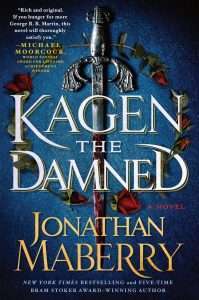 As the title suggests, we follow the titular Kagen, a captain of the palace guard and sworn protector of the royal children, from when he wakes up hungover in a brothel and onwards through the Hakkian invasion and its aftermath. Maberry’s novel is relentlessly fast-paced for most of Kagen the Damned, which I enjoyed. The story is mostly made up of short chapters which maintain momentum but also give easy pausing points if you have yet to have an extended time to read. If you have the time available, you can clear many chapters and feel you have had a satisfying amount of action. The whole novel could even be read in one or two sittings and feel like a good use of your time. There were about three pages at the start of the novel when I was able to appreciate Maberry’s dark humour before we were thrust into action of the enemy invasion, and then off we ran. However, Maberry still has excellent world-building and weaves in this world’s history, geography, and religion without slowing the narrative down. It gives the reader all the context they need to understand the significance of events but nothing more.
As the title suggests, we follow the titular Kagen, a captain of the palace guard and sworn protector of the royal children, from when he wakes up hungover in a brothel and onwards through the Hakkian invasion and its aftermath. Maberry’s novel is relentlessly fast-paced for most of Kagen the Damned, which I enjoyed. The story is mostly made up of short chapters which maintain momentum but also give easy pausing points if you have yet to have an extended time to read. If you have the time available, you can clear many chapters and feel you have had a satisfying amount of action. The whole novel could even be read in one or two sittings and feel like a good use of your time. There were about three pages at the start of the novel when I was able to appreciate Maberry’s dark humour before we were thrust into action of the enemy invasion, and then off we ran. However, Maberry still has excellent world-building and weaves in this world’s history, geography, and religion without slowing the narrative down. It gives the reader all the context they need to understand the significance of events but nothing more.
I have seen Kagen the Damned be described as a ‘swords and sorcery’ fantasy. This is true; there are swords, and there is sorcery, but the novel also overlaps other subsections of fantasy, including being well deserving of a place on the grimdark shelf. It is dark, violent, and at times quite graphic. I would say that Kagen the Damned has quite a high violence level, which might not be for everyone. However, I think it is purposeful rather than an attempt to shock a reader. Especially at the start of the novel, I think that Maberry’s level of bleakness is required to show just how traumatic the events that happen are to Kagen and why they are the catalyst for the world-shattering events of both Kagen the Damned and the rest of the series. I also really enjoyed that female characters were given strong roles in the novel, in particular, Kagen’s mother, the ‘Poison Rose’ is a legendary warrior and personal guard to the empress.
Kagen is an engaging protagonist and not the morally ambiguous lead readers might expect from a ‘grimdark’ novel. Instead, he is a good person who has something very, very bad happen to him and then goes through a sort of post-trauma recovery process. He does not immediately bounce back and embark on a quest to change the world. It was fascinating reading to follow this journey and see the impact it has on Kagen as an individual and the broader impact of the events in Maberry’s world. I had a lot of sympathy for Kagen and this process, but it may also come across as whingey and fall short for some readers. If that is the case, I urge you to persevere as that only lasts a relatively short time, and with Maberry’s pacing, you can move past it quite quickly. The minor characters are also well-written and will presumably play more significant roles in later novels. Still, in Kagen the Damned, they were supporting characters and not part of an ensemble cast. They also give most of the lighter elements to the series, such as the touching relationship between Ryssa and Miri or Tuke’s colourful swearing in many languages.
I only have very minor niggles with Kagen the Damned, and overall, I enjoyed my time reading this novel. I am late to the party as the book was first published in May of 2022, but the great thing is that I can immediately start the second novel in the series The Son of the Poison Rose. Kagen ends on a reasonably steep cliff-hanger, and although the brief epilogue offers a bit of closure, I still have many questions I want answers for. Thank you very much to both Jonathan Maberry and the St. Martin’s Press team for sending over a copy to review Kagen the Damned for Grimdark Magazine 4.5/5.
Read Kagen the Damned by Jonathan MaberryThe post REVIEW: Kagen the Damned by Jonathan Maberry appeared first on Grimdark Magazine.
January 16, 2023
REVIEW: The Last of Us S1 E1
I’ve been waiting for this series perhaps more than any other in recent memory. Based on the best-selling video-game series, The Last of Us E1 follows the grim and weary Joel as he attempts to block out the grief of his past and move forwards in dystopian world filled with quarantine zones, rival factions, and the monstrous infected. The first season is designed to follow the path of the cinematic first game which was first released back in 2013. There has been a lot of anticipation for this series and The Last of Us E1 does not disappoint.
The Last of Us E1 starts with familiar beats to those of us who love post-apocalyptic series. The pandemic hits with a mutant fungus turning humans into aggressive creatures and the army respond by shooting pretty much anyone they can as Joel does his best to get his brother and daughter out of the city. It’s a slow build with powerful bursts of action that follows the game close enough to please the gamers whilst horror fans will spot similarities with The Walking Dead and A Quiet Place. We then skip forwards twenty years to find Joel living in a quarantined zone working odd jobs for ration cards and having built up a reputation as a man not to be crossed. Meanwhile, we are introduced to Ellie, a young girl recently bitten by one of the infected. She is chained to a wall but curiously, she hasn’t turned into one of the monsters. Rebellious factions do their best to fight against the oppressive regime enforced by soldiers and through it all, Joel and Ellie are drawn together though neither of them seem too happy with it.
In any adaptation, casting is difficult and the main players could make or break this series. Based on the evidence of The Last of Us E1, Game of Thrones alumni Pedro Pascal and Bella Ramsay are perfect in their roles as Joel and Ellie. Joel is the grumpy, weary fighter I wanted to see and Ellie is the mature, witty, foul-mouthed battler all gamers will recognize. The costume design, setting, and music are all familiar (I love Gustavo Santaolalla’s soundtrack to the game and he provides the score here too!) and they also feel ready made for the screen. The first episode captured the mood of the game and had that rare gift of satisfying gamers whilst enticing newcomers who are ready to dive into what will be gut-wrenching journey.
The Last of Us E1 is the perfect start to what could be SKY/HBO’s next big hit. We have become more aware of pandemics and quarantines since the game was first released and that only makes the horror of the first episode that much more real and tangible. The Last of Us E1 is a 90-minute introduction to a story full of interesting characters and scenes that will stab you in the gut and twist the knife without a moment’s hesitation. Best put your seatbelt on as this is going to be one hell of a ride.
The post REVIEW: The Last of Us S1 E1 appeared first on Grimdark Magazine.
REVIEW: Blade Runners ‘Black Lotus’ #3 by Nancy Collins and Enid Balám
Blade Runner ‘Black Lotus’ #3 is the third installment in a four-part miniseries sequel to the popular Cartoon Network anime, Blade Runner ‘Black Lotus‘ starring Jessica Henwick and Will Yun Lee. It was a pretty good story brought down by somewhat questionable animation choices and a focus on action over characterization.
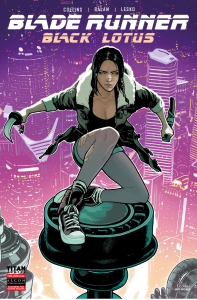 The premise is that Elle is a uniquely skilled and talented Replicant who is not afflicted with the curse that most modern ones possess of supreme obedience. She is a master swordswoman and able to tear through armed guards like wet tissue paper as long as she has a katana. After killing a bunch of crooked bigots, she tried to kill Niander Wallace Junior but failed in the process. Now exiled to the deserts outside of Los Angeles, she has been helping the locals against the boss of nearby Fracktown.
The premise is that Elle is a uniquely skilled and talented Replicant who is not afflicted with the curse that most modern ones possess of supreme obedience. She is a master swordswoman and able to tear through armed guards like wet tissue paper as long as she has a katana. After killing a bunch of crooked bigots, she tried to kill Niander Wallace Junior but failed in the process. Now exiled to the deserts outside of Los Angeles, she has been helping the locals against the boss of nearby Fracktown.
In a surprising turn, the women of the settlers have been kidnapped by the local boss in order to replace the pleasure models that Niander Wallace has reclaimed. This leads to an action-packed scene where Elle infiltrates the Frackers’ plant, slaughters a bunch of guards, and proceeds to mount a daring rescue.
There’s not much to say other than this is a heavy combat-focused work with a few bits of humor like the fact the guards are complaining about the fact they’ll be forced to make do with “real” women rather than pleasure models. It has a bit less of a Wild West feel than the previous issues because it takes place in an industrialized factory as opposed to the California Wasteland, which was a nice change of pace.
The art style remains consistent throughout the comic line, which is both good and bad. The art isn’t something that I really much care for style wise but it’s very good and clear with the action popping off the page. Given so much of this issue and the previous one consists of combat scenes, this is very good. Elle is almost indestructible so there’s not much tension in the books, action wise, but it’s great seeing her tear through the Fracktown goons.
In conclusion, this was a pretty good issue and I’m glad to see more of Elle’s adventures. It’s clear this book isn’t going to do much development of her character or solve any preexisting plot threads, but it does work out as a fun action piece.
Read Blade Runner ‘Black Lotus’ #3 by Nancy Collins and Enid BalámThe post REVIEW: Blade Runners ‘Black Lotus’ #3 by Nancy Collins and Enid Balám appeared first on Grimdark Magazine.
REVIEW: How to Sell a Haunted House by Grady Hendrix
There’s always something odd about the lifeless stares of dolls collecting dust in an empty, seemingly average American home. Soulless monsters, very typically, come to mind. For the horror storyteller of southern vamps and haunted IKEA furniture, dolls are the weird, perfectly intentional, subject to scare all readers. In the tradition of horror movies, How to Sell a Haunted House starts with a phone call and a death. A single mother, anxious about leaving her only child, mourns her parents after a very long, tense coronavirus pandemic, and returns to the home she wants to forget.
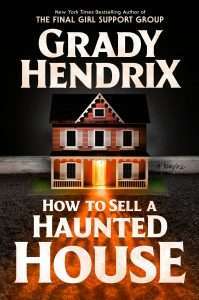 With all her relatives, whom all agree her family is the weirdest of the group, Louise begrudgingly celebrates the Jim Henson-styled funeral with middle-aged women dressed in fairy wings and ushers in pineapple-print dresses. In the childhood home of Mark and Louise are all their family memories and a fluffy promise of inheritance, along with an extremely grim sibling rivalry. Now, empty silence fills the dusty house post the suspicious car accident. All the “junk” of memories, as Louise says, is populated with the eerie silence of dolls, giving the whole house a haunted feeling.
With all her relatives, whom all agree her family is the weirdest of the group, Louise begrudgingly celebrates the Jim Henson-styled funeral with middle-aged women dressed in fairy wings and ushers in pineapple-print dresses. In the childhood home of Mark and Louise are all their family memories and a fluffy promise of inheritance, along with an extremely grim sibling rivalry. Now, empty silence fills the dusty house post the suspicious car accident. All the “junk” of memories, as Louise says, is populated with the eerie silence of dolls, giving the whole house a haunted feeling.
Emotionally and very physically, the house is haunted by their childhood dolls and puppets. One, in particular, is named Pupkin, a puppet with a taste for blood and revenge. Louise’s anger towards her mother becomes the source Pupkin used to manipulate her when she was a child. He was the voice in her head, putting the darkest rage within a frustrated child. Now, an adult, Louise convinces herself and others that those horrible memories are just that. Imagined, inaccurate memories that hold no truth to reality. It’s this which causes the rift between her and Mark, whom Louise perceives as the overly dramatic, lazy grown child their mother always preferred. That’s the thing, though. Memories can be funny, especially when manipulated by traumatic puppets.
Noises actually start going bump in the night, a feral taxidermied squirrel among them. Facing the haunted house, the only conclusion these siblings come to is that in order to sell it, they need to stop covering things up and face their past. Sounds fun. But, as with most families with oodles of bad history, the monstrous puppets get creepier with every uncovered memory.
I loved how intense the feeling of eerie silence is, which amped up with one of the most horrifying puppets I’ve read. It’s amazingly disturbing to watch very real, normal people and their complicated feelings get attacked by an object from their childhood. It’s exactly the type of thing a horror author inspired by the 80s would do. I appreciate the levels Hendrix went to give me those ‘the puppets are alive’ feelings.
Those Freudian memories that Mark and Louise inherited from their mother become a theme of depression, mental health, and family history. The real horror in How to Sell a Haunted House. Childhood memories are often put into childhood toys, which so commonly become an escape from reality into something more comfortable. Hendrix, very clearly, wrote these siblings as intentionally unlikeable people. The most interesting part of this book, for me, was Mark and Louise’s past. The characters that are most interesting are real people with very honest family problems. Louise’s emotional complexity is pulled by losing her mother and father, which Hendrix centers around being targeted by “the forces of darkness,” as her Aunt Gail says. That “How did you get like this” aspect of the story interested me over everything else, including the murderous puppet.
While it’s not necessary to like the characters for me to like a book, there are some other issues that prevented How to Sell a Haunted House from becoming a more enjoyable read. Readers should know that even though what Mark and Louise go through are achingly relatable, they are not set up to be moral standards of humanity. And that’s what makes it such a deep book. They often do and say awful things, which many readers will not like depending on their reading preferences. I tend to prefer morally grey, complicated characters. They are endlessly fascinating to me. Over the course of How to Sell a Haunted House, Hendrix maintains these intense emotional moments, where characters genuinely struggle with their traumatic memories. The tone sets the novel into a very serious horror novel, dealing with very complex issues of memory and family conflict. So it makes it very difficult to take these real issues seriously when a little haunted puppet singsongs things like “…playPLAYplayPLAYplay…” It completely shatters the mood, detaching me from a closer emotional understanding of the characters. In particular, it’s hard to laugh at people terrorized by demonic puppets when you’re focusing on such important mental health issues. Some authors are able to successfully meet that balance, but the tone is really important here. I liked reading this book, but even with what I did like this book is noticeably off-tone and the main plot meanders a bit.
With that criticism in mind, Grimdark fans may enjoy this weird dark tale. Discover bliss in strange horror, hellish family secrets, morally grey siblings, and characters who eat curses for breakfast. How to Sell a Haunted House is gleefully coated in chaos, terror, and screaming puppets.
Read How to Sell a Haunted House by Grady HendrixThe post REVIEW: How to Sell a Haunted House by Grady Hendrix appeared first on Grimdark Magazine.
January 14, 2023
REVIEW: Soulkeeper by David Dalglish
Soulkeeper is the action-packed first volume of David Dalglish’s dark fantasy series, The Keepers.
The novel opens with the reaping hour, a religious rite for the recently deceased, calling upon deities known as the Sisters to release a person’s soul from their body. The ritual is conducted by a warrior-priest known as a Soulkeeper. One of the most interesting aspects of Soulkeeper is the physical manifestation of the souls themselves, glowing orbs that people can witness emerge from a body and ascend toward the heavens.
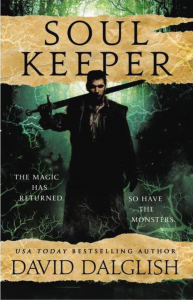 As the most prominent Soulkeeper of his time, Devin Eveson roams the land offering his services to those in need. Unfortunately, a mysterious plague has created an unprecedented demand for his skills. Although the role of Soulkeeper comprises both religious leader and healer, Devin is also a pistol-wielding fighter extraordinaire who will defend innocent lives through any means necessary.
As the most prominent Soulkeeper of his time, Devin Eveson roams the land offering his services to those in need. Unfortunately, a mysterious plague has created an unprecedented demand for his skills. Although the role of Soulkeeper comprises both religious leader and healer, Devin is also a pistol-wielding fighter extraordinaire who will defend innocent lives through any means necessary.
The plague seems to originate from a mysterious black water that is rising throughout the land, similar to the premise of the “Dark Tide” and “Darker Tide” short stories by Mark Lawrence. This black water in Soulkeeper is accompanied by the return of a host of magical creatures, long forgotten by humankind. Much of Soulkeeper concerns people finding their place in a world where they’ve been suddenly displaced by strange and powerful beings. Some of these creatures are friendly towards people, but many are horrifying, including a mountain-sized dragon and a villain who mutilates humans, turning their bodies into macabre works of art.
Soulkeeper features a great cast of characters, including two of my favorite sidekicks in recent memory: the faery, Tesmarie, and the delightful firekin named Puffy. Puffy is a joy and steals the spotlight whenever he is on the page, communicating through his strokes of flame.
At over 650 pages, Soulkeeper is a chonker of a book, but the pages fly by quickly thanks to David Dalglish’s accessible writing style and fast-moving plot. There are plenty of dark moments in Soulkeeper, but these are balanced by a levitous sense of humor. My grimdark heart would have preferred a more consistently bleak tone to the novel, but I appreciate what Dalglish has done here in trying to balance the darkness with more lighthearted elements. The last third of the novel was the best part of the book, taking a definite turn toward darkness and ending with a big emotional punch.
For me, the emotional impact of Soulkeeper deepened when I read the author’s afterword describing the inspiration for the character Devin, a boy by the same name who frequented the author’s boardgame store and passed away from a rare disease as a college freshman. This background helped me to understand the deeper significance of Devin’s role as Soulkeeper and the design of his character as a clean-cut, do-it-all good guy. David Dalglish has also dedicated the book to Devin, describing him as “a great kid who left us far too soon.”
With Soulkeeper, David Dalglish has created a rich and engrossing new world. Soulkeeper is a consistently entertaining read with just the right level of darkness that would serve as a suitable entry point for readers new to grimdark fantasy but not yet ready to dive into the deep end of the genre.
4/5
Read Soulkeeper by David DalglishThe post REVIEW: Soulkeeper by David Dalglish appeared first on Grimdark Magazine.



